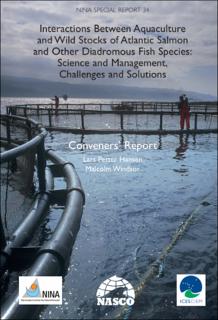| dc.description.abstract | Since the early 1980s, farming of Atlantic salmon has become a major industry with a production in the North Atlantic in 2005 of approximately 0.8 million tonnes, or 380 times the reported catch of wild salmon in the same area. There are concerns about the disease, parasite, genetic and ecological interactions of salmon farming on the wild salmon stocks and a regime is required that allows the industry to prosper while safeguarding the wild stocks. Interactions between wild and cultured salmon are not restricted to those arising from salmon farming. Where fish are deliberately released to the wild, a regime is also required under which the risks as well as the benefits are carefully considered.
In response to concerns about interactions between salmon aquaculture and the wild salmon stocks, a series of international meetings has been convened over the last 16 years to review scientific understanding of interactions and provide guidance on appropriate management responses. The most recent of these symposia, held in Bergen, Norway, during 18 - 21 October 2005, is reported here. It is clear that since the first symposium in 1990 scientific understanding of the interactions between cultured and wild salmon has increased considerably. The latest information presented in Bergen confirms that cultured salmon can have significant negative impacts on the wild stocks. While real progress has been made in managing these interactions, some very significant challenges remain, particularly with regard to further reducing the impacts of escapees and sea lice. A further major development since the last symposium in 1997 is that the representatives of the industry present in Bergen accepted that their industry can have damaging impacts on the wild stocks. This is very welcome because it is a prerequisite to cooperative action, which has developed considerably between wild and farmed salmon interests but which needs to continue and be enhanced if solutions are to be found to the remaining challenges.
The Conveners propose that interactions between farmed and wild salmon need to be virtually eliminated, not just reduced. There are risks not only from farmed salmon but also from inappropriate stocking practices to be addressed. While progress is being made in managing interactions, the large scale of the salmon farming industry means that solutions are urgently required. We believe that progress in addressing the sea lice problem has been made and can continue to be made by concerted action and widespread use of best practice but it is clear that difficulties remain, particularly with regard to protecting wild sea trout populations. The prospect of resistance developing to the available lice treatments is a real concern for both wild and farmed salmon interests. Progress has also been made in reducing escapees but their numbers remain large relative to the wild stocks and they may be irreversibly damaging the stock structure and diversity of the wild Atlantic salmon. In our view, this symposium confirms that containment of farmed salmon must be made much more effective. If physical containment cannot be achieved then the use of sterile salmon may be necessary.
We believe that if no action is taken now, and if the views of the many scientists and experts at the symposium, and the two preceding symposia, are correct, we risk the loss of the diversity of local adaptations in the wild stocks of salmon in the North Atlantic. This may well have serious consequences for their fitness, productivity and ability to survive environmental change. | en_US |
